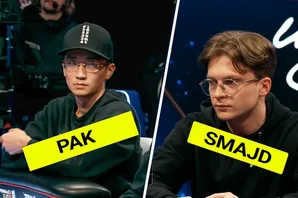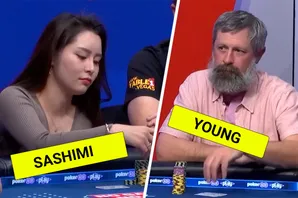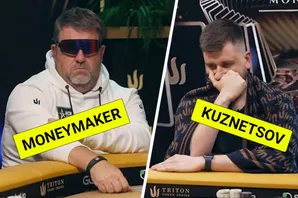In poker, if you don’t know how to bet, you may win hand after hand, but your winnings won’t amount to much. And one of the most basic steps in learning how to bet is to understand the ante. Without that knowledge, you’re stuck at square one and your play won’t leave the amateur zone.
Below, you’ll learn what the ante bet is, why it’s called a “forced bet,” and the ins and outs of similar forced bets. Soon, you’ll sit down with enough confidence and patter to fit in with the pros. You’ll not only sound more like a pro — you’ll feel more like one, too.
Read on to learn all about forced bets, poker antes, and additional bets that you’ll encounter as a beginner.
What is an ante in poker?
By definition, an ante is a forced bet made in the beginning of the round. The term ante means “before” in Latin, so it makes sense that ante bets are made pre-flop. You’ll come across a few types of bets in poker, but the ante is the very first bet of the game and it’s required of all players.
Usually antes are relatively small bets, but they ensure each player has a stake in the game. An ante amount can be as low as a few dollars and can be lower than the minimum bet for the table. If you’re playing a cash game at a club or casino, your ante may be as small as a single poker chip.
After the ante
Once each player has made the ante, the dealer will distribute cards and the game of poker can begin.
One benefit of playing with an ante is the size of the pot. With two to fourteen players at the table, the ante starts the game off with a pot worth winning. It creates a high-stakes situation that engages the players and makes play more exciting. Antes also encourage players to continue playing through to later stages of the game instead of folding.
Not all types of poker games use antes. Texas hold ‘em and PLO (pot-limit Omaha) use different types of forced bets instead of antes.
Types of forced bets
Antes aren’t the only type of forced bets you’ll see in card games, but they’re the most common for cash games and poker tournaments, both online and in poker rooms. Blinds, kill blinds, big blinds, and other blind variants are also common. While learning poker rules, it's a good idea to educate yourself on these and other common poker terms.
Antes
Antes are always made pre-flop, or before the cards are dealt. Other betting intervals are played later in the game, so players continue to bet on their hands at each round.
For example, if five players sit at a poker table and they each need to put two chips in the pot before the first round, then the pot starts out with ten chips. Those chips get the ball rolling. Players receive their hands and feel compelled to continue betting so they don’t lose their ante. But more importantly, they also don’t want to lose the chance to win everyone else’s ante.
Blinds
Some poker games require mandatory bets called blinds before the cards are dealt. But blinds are limited to one or two players based on their physical position to the dealer. You’ll commonly hear about big blinds and small blinds.
The big blind value is the minimum bet for the table. The small blind is valued as half of the minimum bet.
The player to the left of the dealer contributes the small blind. The player to that player’s left contributes the big blind. So now the pot has 1.5 times the minimum bet before the cards are even dealt.
The dealer button rotates clockwise with each round, so the same players don’t make the small blind and big blind repeatedly.
Kill blinds
Many poker games have betting limits. However, when the game becomes too stagnant or a player wins two hands in a row, the winning player may be required to post a kill blind.
The kill blind is a blind bet that’s usually twice the size of the big-blind ante. Kill blinds quickly raise the stakes and force players who keep winning to return some of their winnings to the pot if they want to continue to play poker.
The kill blind can also come into play if the pot becomes bigger than a specified size.
Bring in
Stud games, like five-card or seven-card stud, also have a mandatory bet called a bring-in. The bring-in is usually larger than the ante but smaller than the minimum bet. Unlike an ante, the bring-in bet is made after the initial cards are dealt. Only one player has to play the bring-in.
For example, all players put the ante in the pot, then the dealer deals the cards. The player with the lowest upcard needs either to play the bring-in or place the table’s minimum bet. Each remaining player has to call the bring-in bet or raise.
Post
Sometimes you’ll hear the term “post” when players and dealers talk about betting.
In most traditional instances, to post means to place the starting mandatory bet like a blind, a bring-in, or an ante. Each player posts the ante before game play can begin, or the first two players post the small blind and big blind before cards are dealt.
There are times when a player may join the game after the first cards are dealt. In those cases, the new player must post the same amount as the game’s big blind to the pot.
The term “post” or “posting” applies to both online poker and live poker games.
Why are forced bets used in poker?
Without forced bets, poker players wouldn’t feel compelled to try to win from the very beginning. Mandatory bets make poker games more interesting by immediately engaging players.
Forced bets like antes, blinds, and bring-ins motivate players to stick with the game even if their hand doesn’t seem promising at first. Without a starting pot, the game has low stakes and is far less interesting.
Raising the stakes
Imagine if you sat down at a poker table and you didn’t have to post an ante or a blind bet. If your first few cards weren’t great, you would probably just fold and wait for the next hand. You may start to play game after game hoping to see aces and folding if you don't.
Forced bets are the solution to apathetic poker players. With forced betting, most players don’t want to throw away their initial bets, so they stick around longer to see if their odds improve.
The takeaway
If it seems like a risk to post an ante or a blind before the first betting round, that’s because it is! You have to contribute money to the pot to have the chance of winning big. Fortunately, all players have to post the ante, and eventually each player will have their turn to post the small blind and big blind. This setup creates a level playing field.
While plenty of people play poker purely for the chance of winning money, many players do it for the thrill. Mandatory bets both increase the winning potential and add to the excitement of every card game.
Featured image source: Flickr by Chris Vaughan used under CC license



























